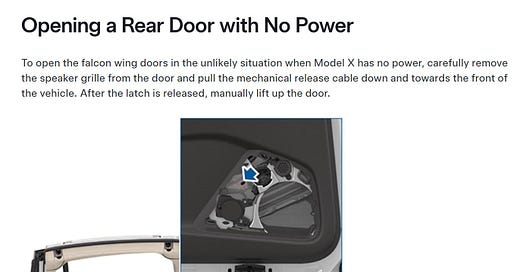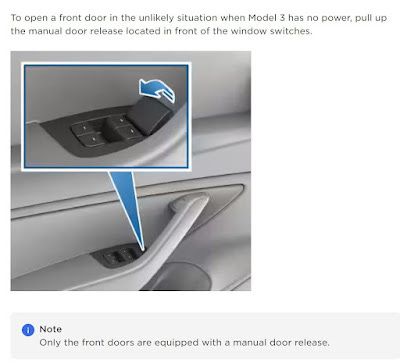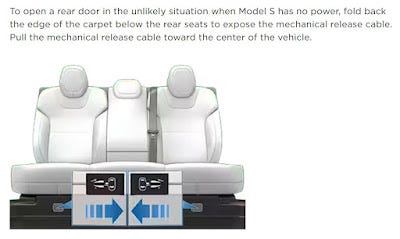People are still being burned alive in Teslas
Tesla manual door releases are a deadly problem. It just happened again.
Yet another tragic story of people being trapped inside a burning Tesla, this time in Toronto. Four dead; one rescued when a bystander smashed a window: https://www.msn.com/en-us/autos/news/four-passengers-die-after-being-trapped-in-burning-tesla-after-electronic-doors-seemingly-wont-open/ar-AA1tYcwj
This has been going on for years. At least some of the victims were definitely alive and trying to escape a burning Tesla when door lock power was lost. Some escaped. Some did not. Below is a writeup I posted on a blog in 2022. Nothing has really changed. The Tesla door release situation is a fatality-via-burning-alive waiting to happen. As it has multiple times at this point.
The usual Tesla fan response is that drivers are responsible for knowing the arcana of their car and, apparently, deserve to die if they cannot operate a manual release in a crisis. In some models this requires removing a speaker grill. While the car is actually on fire.
I have even less sympathy for that argument when casual passengers in the back seat don’t know the emergency release is under the carpet (model S), possibly requiring a screwdriver to access, or that there is no emergency release in the back seat at all (model 3). Do you read the owner manual when someone gives you a ride? Is it OK to not be able to open rear doors when the battery catches fire after a crash? This is a problem long past due for improvement.
After this example picture of the situation is a longer story I wrote more than two years ago on this still-troubling issue…
Picture source: https://www.tesla.com/ownersmanual/modelx/en_us/GUID-AAD769C7-88A3-4695-987E-0E00025F64E0.html
Phil Koopman, (May 25, 2022) The Tesla manual door releases -- and lack thereof in some cases -- present unreasonable risk. What in the world were they thinking? Really bad human interface design. The door handles are not operable from the outside if electrical power has been lost. And from inside you need to use a manual release. Cool design shouldn't come at expense of life critical peril. This article sums up the latest, but this has been going on for a long time.
Tesla fans seem to be saying that it is the driver's responsibility to know where the manual release latch is to escape in case of fire. Anyone who doesn't is (and has in past fires) been ridiculed on-line for not knowing where the manual release is hidden. Even if they died due to not successfully operating the control, or having to kick the window out, somehow they are the idiots and it is their fault, not Tesla's. (If someone you love has died or been injured in this way you have my sympathy, and it is the trolls who are idiots, not your loved one.)
On-line articles saying "here's how to operate the door release so you don't die in a Tesla fire" tell you there is a problem. This design is unreasonably risky for real world use. A "bet you didn't know -- so here is how to not die" article in social media means there is unacceptable risk. Example: "Tesla Model Y fire incident: remember, there's a manual door release, here's how to use it in an emergency."
Front doors you have to lift up a not particularly obvious lever in front of the window switches that is easy to miss if you don't know it is there. Maybe if you have used it a few times -- but if you never realized it is there or you have rented/borrowed the car, good luck with that. I'd probably have trouble finding it even if I weren't suffocating from smoke from a battery fire. (Have you ever had to consult the owner manual to find your hood release? Imagine doing that to find out how to open the door when your car is literally on fire -- oh, but if it is an electronic manual and you've lost power, you can't do that on the center console, can you?)
And if you're a passenger and driver is unconscious you will have issues. Do you read all the safety instructions in the driver manual when you catch a quick ride as a passenger with a friend? Does your friend brief you on escape safety features so you can exit before a 5 minute ride? Thought not.
But wait, there's more (pictures later in this writeup).
Model S rear door: "fold back the edge of the carpet" to find a pull cable; some report needing a tool to access the pull.
Model X falcon wing doors: "carefully remove the speaker grille from the door and pull the mechanical release cable..." You might need a tool to do this as well.
Model 3 rear door -- NOT EQUIPPED WITH MANUAL RELEASE (from manual: "Only the front doors are equipped with a manual door release")
So I guess the passengers in the back are kind of expendable. Good to know when you’re in the back seat of a Uber/Lyft Tesla ride.
This is stunningly bad human interface design. It is entirely unreasonable to expect an ordinary car owner to know where a hidden/non-obvious emergency control is and activate it when they are trapped inside a burning car. Possibly using a tool they don’t have available. Let alone passengers. Apparently without mandatory training and mandatory periodic refresher training.
Anyone who thinks it is reasonable to expect someone not trained in military/aviation/etc. to get this right probably has not served or been through that type of training. I have been through tons of training. Emergency drills that might give some nightmares (sealed inside a tank with broken pipes and told to plug the flooding was extra-special — all three times). And sometimes the real thing. Not always with perfect execution, because there is compelling data showing humans suck at performing complicated, non-reflex-trained tasks under stress (and thus, more practice, more drills).
Education and shaming won't prevent the next death from this unreasonable risk. Everyone should be thinking twice about risking their life on this hot mess of an egress system.
I can't imagine why NHTSA wouldn't want to do a recall on this.
(To the extent this is true of other brands that is equally problematic. See notes below.)
PICTURES:
Front doors & Tesla Model 3 no rear door release:
Tesla Model S rear seat door release:
Apparently these require tools to actuate: "To reach the manual releases for the rear doors, you have to remove a rubber mat at the bottom of their storage boxes. After that, you have to open a small plastic lid, which the TFL folks only managed to do with a flat-head screwdriver. Again, it is a procedure that demands tools and accurate information. Imagine if the car is on fire just after a crash…"
Tesla Model X falcon wing door release:
Updates since the original story:
A Linkedin commenter pointed me to this story about a Corvette fatality related to a similar issue. From what I can tell repair parts for Corvettes indicated a clearly marked egress pull that is on the floorboards. So not ideal, and possibly difficult to see if you are already in the seat. Worth reconsidering. But not literally hidden (or missing) as in Teslas, and certainly not in vehicles being sold as family cars or prevalent as ride hail vehicles. Perhaps now that Tesla has pushed the enveloped past any reasonable limits it's time for standards on egress actuator visibility and accessibility.
This has been a known issue at least since a 2019 crash, summarized here: https://www.autoblog.com/2019/02/28/tesla-fiery-crash-closer-look-door-locks/ That fatality also had to do with door handles not popping up after a crash, so a rescuer was unable to open doors from the outside. It's time to pay attention before more people get trapped inside burning cars.
A new incident in 2024 is even more concerning:
An adult buckles a toddler into the back. Closes the door. And immediately finds the front door won't open because the vehicle is dead. Kid trapped inside. Firefighters smashed the window. (This is summer in Arizona -- waiting for the workaround that apparently involves a battery charger is not a great idea. And what if the electronics had failed instead of just a battery issue?)
The article points out that other car makers have a key for the trunk that accesses a manual door release lever. It is long past time for Tesla to up their safety game on their emergency egress features.
Yet another tragic story of people being trapped inside a burning Tesla in late 2024, this time in Toronto. Four dead; one rescued when a bystander smashed a window: https://www.msn.com/en-us/autos/news/four-passengers-die-after-being-trapped-in-burning-tesla-after-electronic-doors-seemingly-wont-open/ar-AA1tYcwj








The devil is in the details, in particular in the case of very complex systems like today’s vehicles. User friendly design and thorough testing should be priorities even for seemingly simple devices like door looks.
Just reading your comments for the first time and wondering if you are a member of the Association for the Advancement of Automotive Medicine. Started by 6 physicians in 1957, membership expanded to other professionals and countries. Great organization that I was a member of for many years before my retirement from Academic Emergency Medicine. Worth taking a look at.